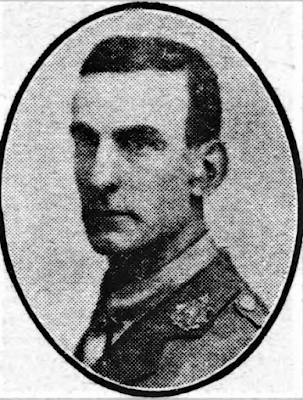LIEUTENANT LESLIE PEVERIL SUTCLIFFE, ROYAL ENGINEERS. DIED FROM INFLUENZA, 4th NOVEMBER 1918 AGED 27.
LIEUTENANT
LESLIE PEVERIL SUTCLIFFE, ROYAL ENGINEERS. DIED FROM INFLUENZA, 4th NOVEMBER
1918 AGED 27.
It was late October 1918 that Leslie Sutcliffe
arrived in the little town of Smithers high in the Rockies Mountains of British
Columbia. As the days shortened and winters grip began to take hold he rented a
room at a boarding house in the town. His general health was already poor and
now he was suffering from the effects of influenza, probably Spanish Flu.
Within days his condition worsened and he succumbed to this deadly disease on
the 4th of November.
Born in Sowerby Bridge on 3rd August 1892
Leslie was the second son of Henry and Kate Sutcliffe. His father was a
prosperous solicitor and wool merchant who was able to send his sons to
boarding school, in Leslies case first to Sedburgh and then Uppingham where he
was a member of the Officer Training Corps. After School instead of taking a
place at university as might be expected of a boy from his background he went
to work as an apprentice engineer for Messrs Greenwood and Batley, Kirkstall
Road, Leeds. By now the family had moved from Halifax across to Ilkley where
they lived at ‘Linndale’ on Wells Road.
Leslie enlisted on the opening day of the war into a
Territorial Army unit The Northern Signals Company of the Royal Engineers as a
motorcycle despatch rider. However, his public school education and background
marked him out as officer material and on the 6th February 1915 he
was commissioned as a 2nd Lieutenant in the Royal Engineers.
In June 1915 Leslie arrived at the Gallipoli front
in Turkey and was attached to a Signals unit of the Royal Engineers. As the
campaign became bogged down a new attack was planned at Sulva Bay on the 6th
of August. Leslie went ashore to assist with the laying of telephone cable
across the beach which was under constant enemy bombardment. It was whilst
fulfilling this task that he was wounded in the left foot on the 10th
August. Evacuated away from the front to the island of Lemnos for treatment he
contracted dysentery and rheumatic fever. This necessitated a transfer back to
Egypt where he was treated at the General Hospital in Alexandria. The treatment
of rheumatic fever was very problematic in a time before the use of antibiotics
and the illness appears to have caused cardiac problems and a consequent return
to Britain for further treatment. Clearly much weakened by the illness he was
honourably discharged from the army in the summer of 1917 now unfit for any
type of military duty.
It is clear that the devastating effects of
dysentery and rheumatic fever required many months of recuperation and it is
probable that during this time he formulated the idea of emigrating to Canada
to seek a new start. Contemporary accounts state that Leslie believed that an
outdoor life in a drier climate would help relieve his symptoms particularly
the long lasting effects of rheumatic fever. On 3rd June 1918 he set
sail from Liverpool aboard the Canadian Pacific Steamer Scandinavian bound for
New York giving his occupation as engineer and farmer.
It was four months later that Leslie arrived in
Smithers probably already ill and desperate for somewhere to stay. His death
certificate states that de died of influenza and it is almost certain that his
previous illnesses and his weakened state contributed to his final demise.
However, rheumatic fever often reoccurs and with symptoms similar to influenza
and it is possible that his death was attributable to the illness that he had
contracted whilst on active service. It was at 4pm on the afternoon of November
8th 1918, as the sun sank behind the majestic back drop of the
Rockie Mountains that a local undertaker laid to rest Leslie’s mortal remains.
Leslie Peveril Sutcliffe is not recorded by the
Commonwealth War Graves Commission as his death occurred after he was
discharged from the army. Instead his headstone appears to have been provided
by his family, although, this now lies in pieces. In 2014 ‘Ilkley remembers’
contacted the Royal Canadian Legion and asked them to commemorate this son of
our town and on Remembrance Day they laid a wreath of poppies on his grave. Not
forgotten, he is remembered with pride on our war memorial here in Ilkley and
at St Margaret’s Church on Queens Road.




Comments
Post a Comment